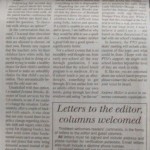ThisWeek UA 1/5/2011
Upper Arlington Schools rank at the top of several state and national ratings. But are they still missing the mark on school lunch?
When we started our daughter in the Burbank Early Childhood School, I felt comfortable knowing that she would be in an exceptional learning environment. My wife and I attended the pre-enrollment meetings and read the information packets cover-to-cover. In fact, the packets are so good they are now wrinkled and dog-eared because they included not only the structure and ideals behind the school but also dead-on accurate child development – information that we regularly refer to.
That’s why I was so confused after her first day of school, when my daughter exclaimed, “Daddy, we had chocolate milk and syrup for lunch!” What?! Following her second day, when I asked about her lunch, she would only tell me how much she loved the chocolate milk. At the parent teacher conference the evening before her third day, I asked the question, “Is chocolate milk always an option?”
In the conversation that ensued, I learned that chocolate milk is a daily option and children are allowed to choose, on their own. Parents may request that the teachers only let their children have white milk but my feeling is that in doing so a parent trying to make a healthy choice for their child’s nutrition is forced to make an unhealthy choice for that child’s socialization; they automatically become the odd-man-out.
Unsatisfied with that option, I e-mailed JoAnna Brooks, director of food services for the UA schools, to see how we might change the situation. Unfortunately, after a couple back-and-forth emails, it was clear that not only would there be no policy change in regards to chocolate milk and sugary sides (like syrup for dipping foods in), but there were some other fundamental issues such as using utensils and plates that were being detoured around instead of addressed directly.
According to one of Brooks’ e-mails, “On days when only white milk was offered, milk consumption dropped an average of 27 percent.” She goes on to argue that the chocolate milk increases the number of students drinking milk. Brooks believes that this is preferred because milk provides calcium and vitamin D. However, if you take a look at the amount of sugar and caffeine contained in a box of chocolate milk, you’ll notice you are paying for that calcium and vitamin D at the cost of essentially giving your child a can of Coca-Cola; and that’s without mentioning the milk fat.
More to the point though is, in the U.S., we are suffering epidemics of obesity, diabetes and ADD/ADHD among our children. We are witnessing one of the few generations in history expected to live shorter lives than their parents.
We are not, however, facing an epidemic of calcium and vitamin D deficiency. Especially not in Upper Arlington.
When I followed up about the school not providing regular meal utensils and using disposable items instead of reusable, washable trays, Brooks explained that disposable items are more economical. The same is true for the use of plastic “sporks” instead of flatware.
Even if I accept this financial argument to be true (which I do not, otherwise I would be a fool to own dishes in my own home), I find the lesson here to be exactly opposite what we should be teaching our children. Namely, that everything in life is disposable.
In regards to using sporks instead of flatware, Brooks stated that the director of Burbank requested them because some children have a difficult time using forks, knives and spoons. If a child is unable to use a fork and a spoon, I am baffled at why they would be able to use a spork significantly better – a utensil which makes neither a good fork or a good spoon.
For a school system that is so incredibly well thought out, from early pre-school all the way through graduation, I was shocked that the school lunch program is so mediocre. It’s as if school lunch is just an after thought, something to just get through – not unlike how often we as adults treat our own meals, going through fast-food windows and eating “on the run,” while our health deteriorates.
Instead of lunch being treated as an after thought, shouldn’t our schools – the same school system that strives for academic and athletic accolades year-in and year-out – use lunch period as yet another opportunity to excel?
I feel like our current school lunch program plays to the lowest common denominator. Why not challenge children who refuse to eat healthfully; instead of challenging parents who want their child to eat healthfully? Why not challenge children who haven’t learned to use proper utensils and table manors to learn those things? Why not teach our children that this isn’t a disposable world, everything has value.
I believe there are a lot of lessons about respect (for our world, for the things around us, for each other) that can come out of a simple lunchtime meal.
Recently President Obama, at the behest of parents and pediatricians across the country – not to mention his wife, First Lady Michelle Obama – overhauled the Federal school lunch program with the Healthy, Hunger-Free Kids Act. While I hope that this overhaul at the federal level has a real, positive effect at our local level, I won’t believe it until I see it; not based on these discussions I’ve had with our school’s leadership.
In January, the PTO Presidents meeting will include a discussion around this topic and what could be done. I hope with the PTO’s support, we might shift school lunches beyond the level of they are stuck in today.
If, like me, you are concerned about our school lunch program please contact the school and let your voice be heard.
